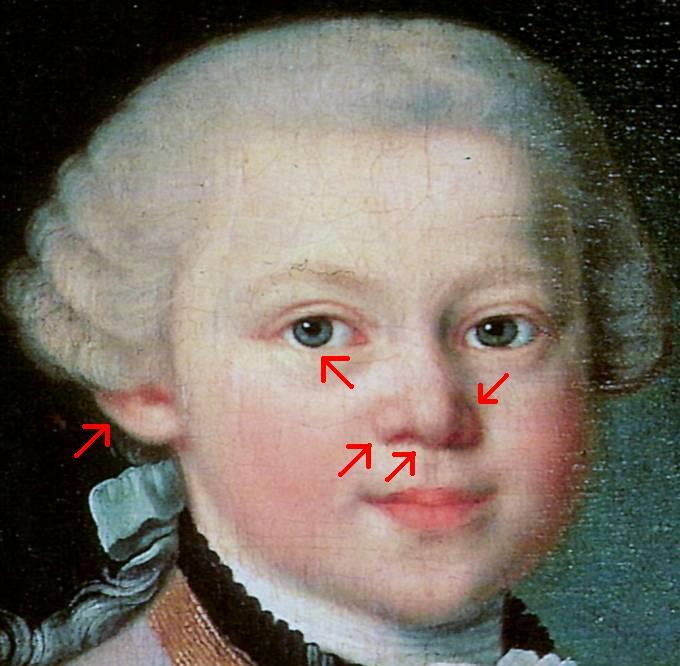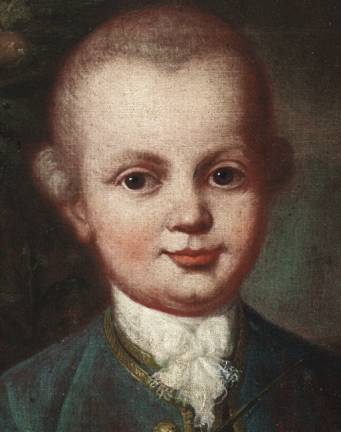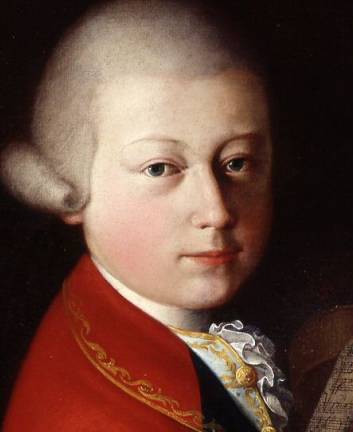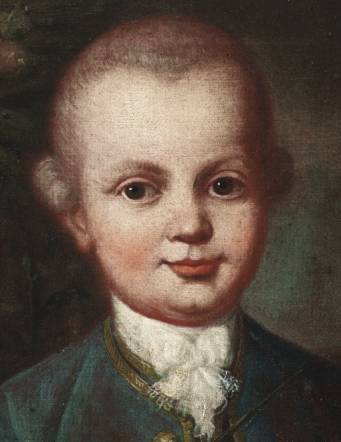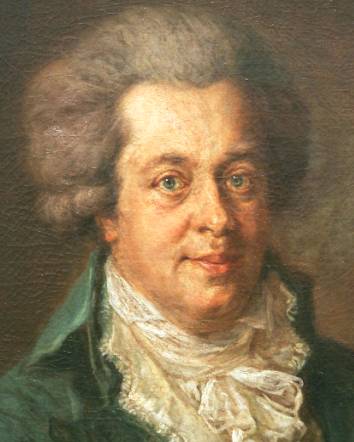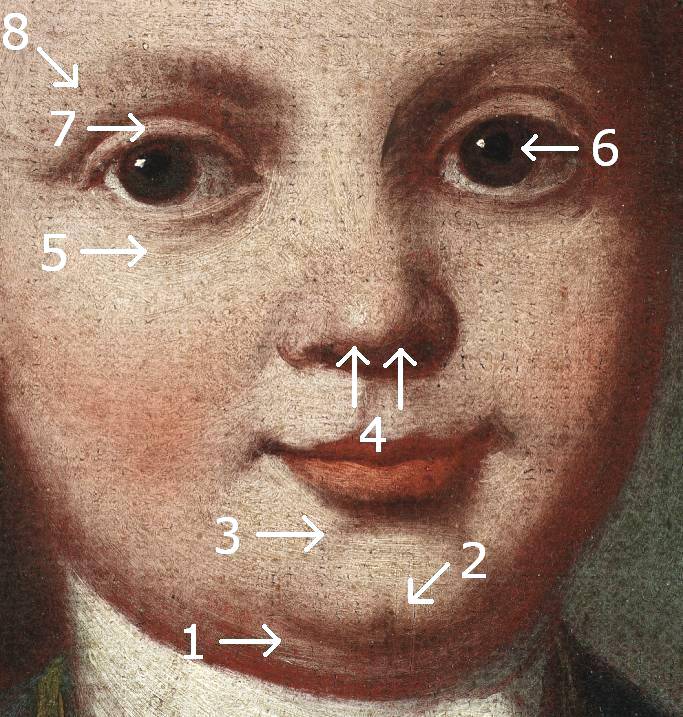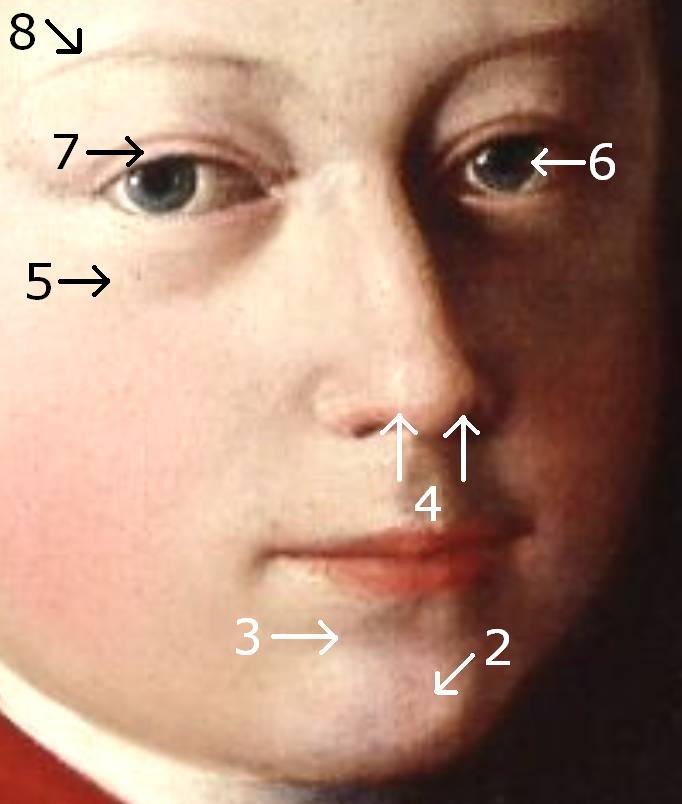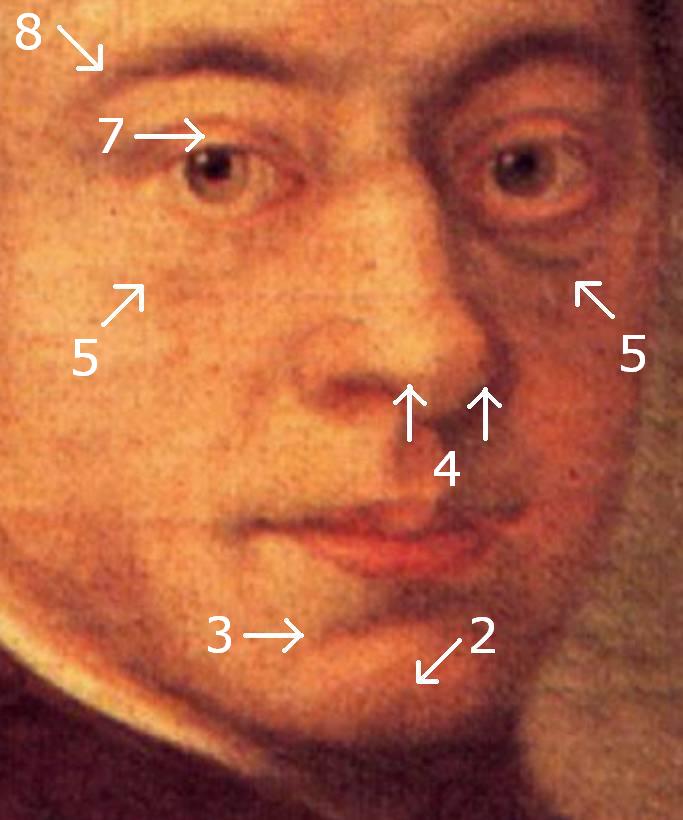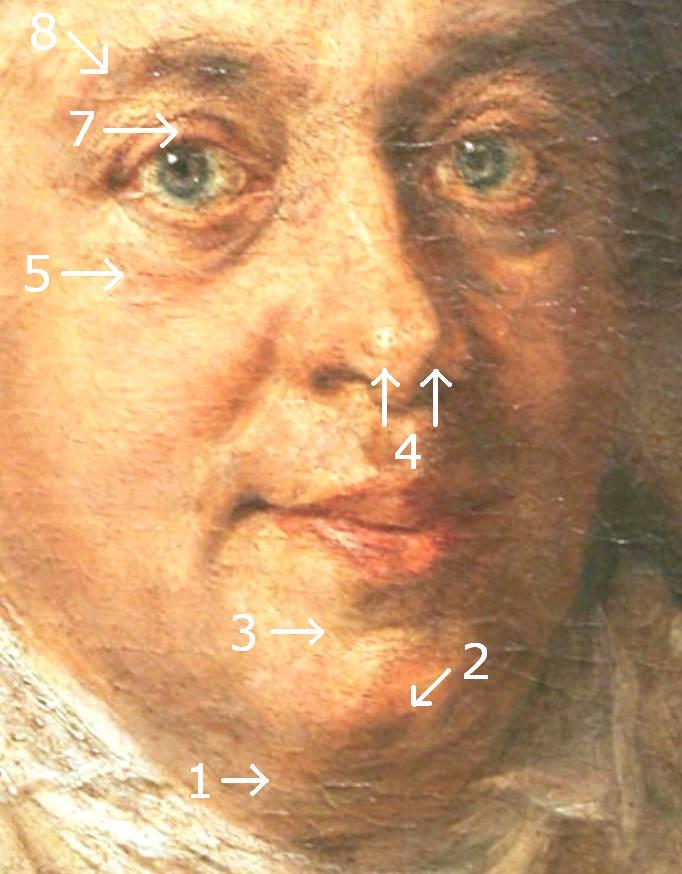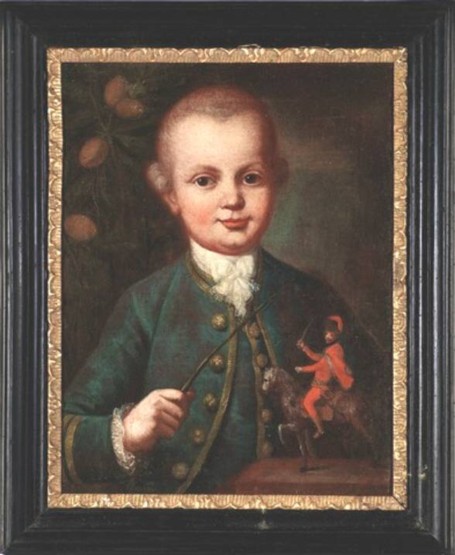
The earliest portrait of W.A. Mozart -
A biometrical statistical analysis of the newly discovered Fruhstorfer Mozart from c1762
Martin Braun - August 2013
The painting is in oil on canvas, 49 x 37 cm, apparently still with its first frame, 62 x 50 cm. The portrait was sold in 2010 from a private home about 70 km from Salzburg in Austria, where it had been from 1922. Before that year the portrait was owned by the Austrian brewer family Fruhstorfer. The earlier provenance is not known. It is known, however, that in 1850 Rosina Fruhstorfer and her husband Siegmund Hoffmann became the owners of the pub Bergerbräu in the Linzergasse in Salzburg. This traditional Salzburg pub, which is documented from 1413, was in the neighborhood of W.A. Mozart's home. In 1777 W.A. Mozart was invited to the wedding of the brewer of the Bergerbräu.
1) Photographs of the painting (Figs. 1-4)
2) The status of scientific identification of faces in paintings
3) The three Mozart portraits used for comparison
4) Biometrical statistical analysis
5) Reference images (Figs. 5-10)
6) Where was it painted?
7) Literature
8) The author
9) Update January 2016
1) Photographs of the painting (Figs. 1-4)
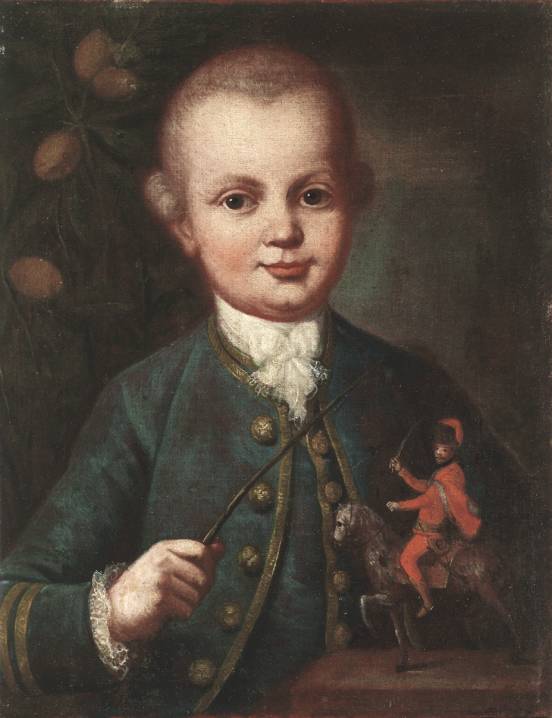
Fig. 1 The painting "The Fruhstorfer Mozart" without frame, 49 x 37 cm.
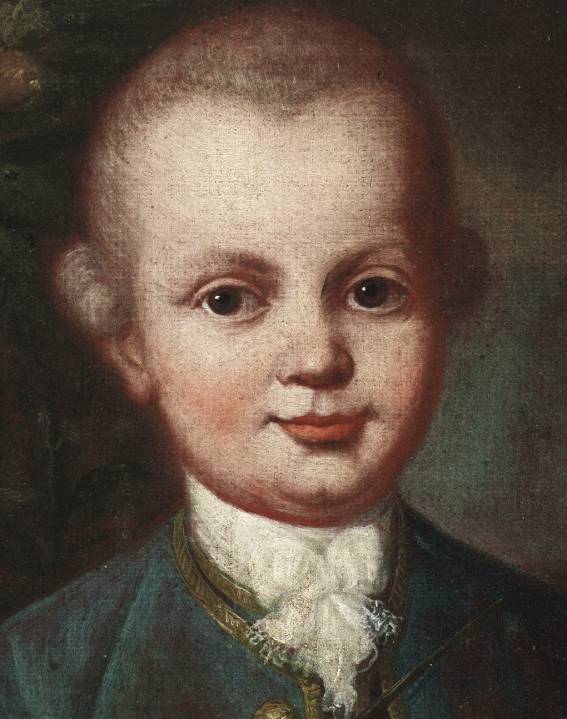
Fig. 2 The painting "The Fruhstorfer Mozart", head and shoulders.
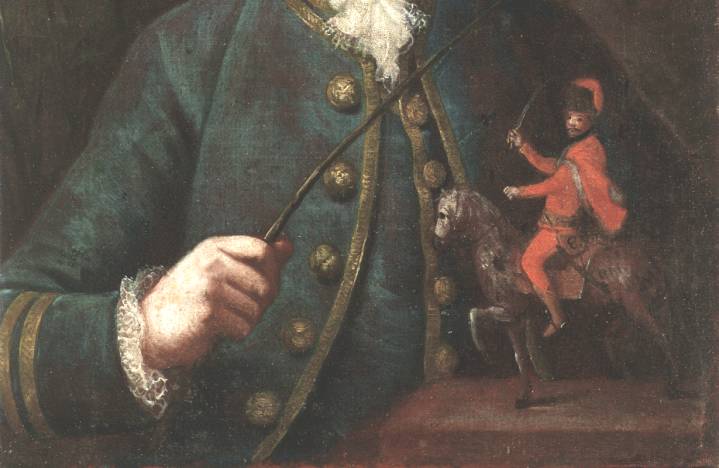
Fig. 3 The painting "The Fruhstorfer Mozart", lower part.
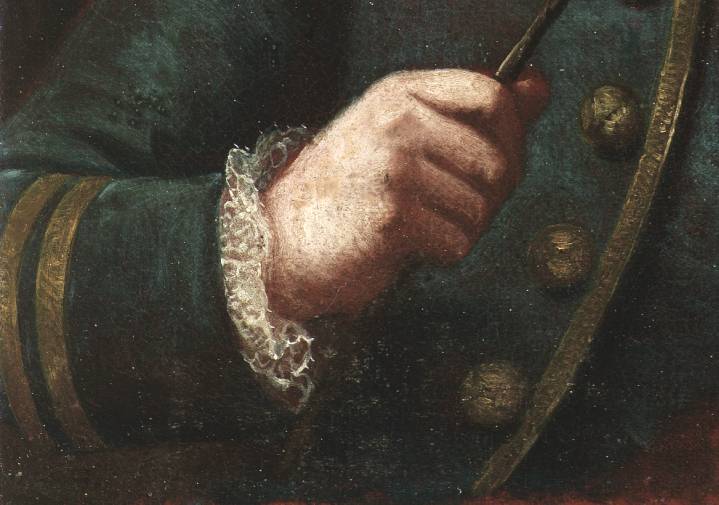
Fig. 4 The painting "The Fruhstorfer Mozart", hand.
Scientific identification of faces in old paintings is still a young discipline. Until a few years ago one could even hear the opinion that the whole discipline was a false beginning. In arts we would be dealing with artifacts, not with images that mirror reality such as in photography. This view, however, is based on a serious category error. From the age of the Renaissance until the beginning of the age of photography, portrait painters worked under a condition of strictly limited freedom. They were commissioned to produce a facial image that would generally be recognized as faithful by anybody who had seen the depicted person. Only in a few exceptional cases could facial traits be arbitrarily altered. As a rule, they had to be reality-bound.
Due to the increasing importance of forensic face identification from
digital photos, and due to the success of scientific face identification
in much discussed cases of Shakespeare portraits and Mozart
portraits, opinions have changed dramatically in recent years. Today
researchers are funded even for the exploration of possible merits of
software-based face identification in arts (1, 2).
3) The three Mozart portraits used for comparison
The Mozart portrait that would be the historically closest one is the
so-called Lorenzoni Mozart (Fig. 5). It was commissioned
by the father, Leopold Mozart, and is today attributed to the year 1763
and the painter Pietro Antonio Lorenzoni. However, it had to be excluded
as a reference portrait for the present study due to grave painting errors.
In 2006 a newly discovered boy portrait was found to be a partly altered
copy of the Lorenzoni Mozart (3). At that time an investigation
of the case had revealed the following painting errors in the Lorenzoni
Mozart:
Quoted from the paper of 2006 (3):
"A close inspection of the Lorenzoni Mozart reveals that the painter
made several technical mistakes that a skillful portrait painter would
not make. First, the general impression is that we are dealing with a
face that is adult-like. In particular, the proportions of the forehead
and of the chin are typical for adults, but untypical for a child aged
seven. If these parts are cut off, the face suddenly becomes child-like.
Another serious construction error lies in the treatment of the perspective.
The frontal plane of the head looks pressed-in at its right side, because
the right-side plane of the head is given too much space on the canvas.
The horizontal distance between right eye and right ear is much too long.
Besides the two global errors there are also five major errors
in face details:
1) The right side of the nose is considerably higher than its left side.
Such an asymmetry never occurs in a healthy nose, and it does not occur
in other Mozart portraits.
2) The lower part of the nose is bent toward the right. Also this asymmetry
never occurs in a healthy nose, and it does not occur in other Mozart
portraits.
3) The shadow on the left side of the nose is wrong in four respects:
a) too dark, b) too sharp at its edges, c) too high up along the nose,
d) straight line cuts across nose tip, instead of circling around it.
4) The left eye is focused on the observer, but the right eye is slightly
turned lateral. This condition does not occur in other Mozart portraits.
5) The lower part of the right ear is highly unnatural and fully incompatible
with other Mozart portraits."
Therefore, instead of the Lorenzoni, the chronologically next Mozart portrait
that is universally regarded as authentic was used. It is the portrait
painted by Saverio dalla Rosa in 1770. For additional comparisons
also two portraits of the adult Mozart were used. These are the so-called
Bologna Mozart from 1777, which is universally regarded as authentic,
and the so-called Edlinger Mozart from 1790, which is today widely
regarded as authentic both by the general public and by art historians
in Berlin (4) and in Vienna (5).
4) Biometrical statistical analysis
A. Landmark test on non-identity
Face identification is largely determined by proportions and angles of
landmark distances, such as length of nose. In the present case, one has
to take into account that facial proportions in a six-year-old deviate
sharply from those in a fourteen-years-old or in an adult. In the child,
forehead and eyes are proportionally larger, whereas nose and chin are
proportionally smaller (Fig. 6). Further, it must be
taken into account that in the dalla Rosa the top of the forehead is covered
by a wig. Considering these circumstances, the new face does not reveal
one significant landmark deviation from either of the two reference faces
in Fig. 6. Thus, the landmark test on non-identity is
negative, and identity of the subjects remains possible.
B. Feature test on non-identity
Most faces have a number of non-general features, such as a vertical indentation
in the middle of the lower part of the chin. Comparison of such features
between the Fruhstorfer and the dalla Rosa shows three differences. In
the dalla Rosa the hanging cheeks with a skin fold under the chin (trait
1 in Figs. 7 and 10) are absent,
possibly concealed by clothing. In the Fruhstorfer the elevation on the
ridge of the nose and the horizontal indentation across the root of the
nose (see Figs. 8-10) are absent.
Because each of the three differences can be accounted for by the difference
in age, also the feature test on non-identity is negative, and identity
of the subjects still remains possible.
Excursus: Comment on the eye colors of W.A. Mozart
Heterochromia iridum is a condition where either the two eyes differ in
color of the iris (complete heterochromia) or the color varies within
an iris (sectoral heterochromia). From the large number of portraits of
W.A. Mozart that we have today we can conclude that his eyes almost certainly
had sectoral heterochromia. Each of the five portraits presented in this
study clearly shows this condition (enlarge images up to 200 %, if necessary).
Lorenzoni (Fig. 5): right eye, gray-blue - left eye,
gray-blue plus light-brown.
Fruhstorfer (Fig. 7): right eye, brown (upper part)
plus gray (lower part) - left eye, brown (more centrally) plus gray (more
peripherally).
Dalla Rosa (Fig. 8): right eye, gray - left eye, gray
plus brown.
Bologna (Fig. 9): right eye, brown plus light-brown
(or gray) - left eye, brown plus gray.
Edlinger (Fig. 10): right eye, light-gray-brown (centrally)
plus gray (peripherally) - left eye, light-gray (centrally) plus gray
(peripherally).
Additionally, it should be noted that in art history the eye colors in
old portrait paintings are considered as notoriously unreliable for the
following reasons.
- Both pigment layers and varnish can change chemically and physically
with age resulting in color alterations.
- Dependence on illumination of the painted person.
- Dependence on curiosity of the artist to examine the eye colors closely.
- Dependence on illumination of the finished painting.
In conclusion, portraits of W.A. Mozart typically show multi-colored eyes,
which would be consistent with the condition of sectoral heterochromia
iridum. Differences in apparent eye-color combinations across Mozart portraits
can easily be accounted for by circumstantial conditions.
C. Digital feature test on identity
Many faces have a number of digital features. These are features that
are either obviously present or obviously absent. If two portraits, for
which the non-identity tests have been negative, have a sufficient number
of digital features in common, the probability of subject identity can
be determined statistically. The following eight digital features appear
in the Fruhstorfer and at least one of the reference portraits (Figs.
7-10):
1) Hanging cheeks with a skin fold under the chin.
2) Vertical indentation in the middle of the lower part of the chin.
3) Horizontal wrinkle line between mouth and tip of chin.
4) A nose tip with two tip-defining points.
5) Dark half-circles (suffused skin tissue) below the eyes.
6) Left eye more widely opened than right eye.
7) Fold of upper eyelid in parallel to and displaced from edge of eyelid.
8) Thinning-out in the lateral third of the right eyebrow.
Excursus: Comment on feature 6
The occurrence of this trait in a painted portrait is a fortunate one,
because it provides additional evidence. The trait is not very rare, but
painters tended to neglect it. In photos it had a prevalence of 9 %, but
in paintings one of only 5 % (see below). The human brain is extremely
sensitive in noting slight changes in the distance between lower and upper
eyelid, because such changes are essential elements in emotional expression.
For this reason, size differences between the two eyes of a portrait are
easily detected. If artists wanted to do an extra favor to a customer
with such a condition, they could give it a special treatment. In our
case, the left eye is measurably more widely opened in the Fruhstorfer
(Fig. 7) and in the dalla Rosa (Fig. 8).
Interestingly, in the Bologna (Fig. 9) and in the Edlinger
(Fig. 10) there is no measurable difference but an
apparent one. In both paintings the artists made the left eye appear bigger
by skillful manipulation of local brightness. The painter of the Bologna
over-emphasized the brightness of the edge of the left eye's lower lid,
whereas Edlinger made the right eye appear smaller by over-emphasizing
the shadow below the upper lid and by adding extra brightness to the reflection
zones above and below the left eye. Tricks of this type protected artists
against possible accusations of unfaithfulness on the one hand, and disrespectful
realism on the other hand. If asked, they could reply: "The left
eye looks bigger to me," in the first case, or "Both eyes are
of the same size - you can measure them," in the second case.
Because the eight features are visible in almost all common light conditions of portrait painting, their frequency in the general population could be determined by feature counts in public portrait galleries.
A corpus of 132 adult Caucasian male portrait paintings was established by extracting naturalistic style portraits that were available in sufficient resolution from the internet archives of the Gemäldegalerie in Berlin, the National Gallery of Arts in Washington D.C., the National Gallery in London, and the Musée du Louvre in Paris.
A corresponding corpus of 108 portrait photographs was established by extracting, in order of listing, the results from Google picture searches that included the search term "portrait".
The count of feature frequencies, separately for paintings and photographs, revealed that in both databases trait 1 and 3 appeared in the same face more often than could be expected from their single frequencies. This observation is biologically plausible, because the probability of both traits is likely to increase with the amount of under-skin tissue in the lower jaw. Therefore, the co-occurrence of these two traits in a face had to be considered as a single new trait.
Similarly, the count of feature frequencies, separately for paintings and photographs, also revealed that in both databases trait 5 and 7 appeared in the same face more often than could be expected from their single frequencies. Also this observation is biologically plausible, because the probability of both traits may depend on qualities of under-skin tissue that are similar above and below the eye. Again, the co-occurrence of these two traits in a face had to be considered as a single new trait.
The feature frequencies were as follows:
1 and 3) Hanging cheeks with a skin fold under the chin AND horizontal wrinkle line between mouth and tip of chin: 8 % in paintings, 6 % in photographs.
2) Vertical indentation in the middle of the lower part of the chin: 46 % in paintings, 31 % in photographs.
4) A nose tip with two tip-defining points: 7 % in paintings, 7 % in photographs.
5 and 7) Dark half-circles (suffused skin tissue) below the eyes AND fold of upper eyelid in parallel to and displaced from edge of eyelid: 8 % in paintings, 9 % in photographs.
6) Left eye more widely opened than right eye: 5 % in paintings, 9 % in photographs.
8) Thinning-out in the lateral third of the right eyebrow: 2 % in paintings, 2 % in photographs.
Next, these six features or feature combinations were tested on correlations. Because all tests were negative and because there is also no biological rationale to assume any correlation, the six features have to be considered as stochastically independent. Thus, the frequency of their joint occurrence is computed by multiplication of the single frequencies. The results for the probability that two non-relatives have the six features in common are one in over 4,800,000 re the painting database, and one in over 4,700,000 re the photo database.
Further, it should be noted that the probability estimate would have
been even stronger, if non-digital features such as the shape of the corners
of the mouth had entered the calculation.
5) Reference images (Figs. 5-10)
Fig. 5 Five major painting errors in face details of the Lorenzoni Mozart (see sect. 3).
Fig. 6 Global comparisons with the dalla Rosa (1770) and the Edlinger (1790).
Fig. 7 The facial traits used in the present study in the Fruhstorfer Mozart (c1762).
Fig. 8 The facial traits used in the present study in the dalla Rosa Mozart (1770).
Fig. 9 The facial traits used in the present study in the Bologna Mozart (1777).
Fig. 10 The facial traits used in the present study in the Edlinger Mozart (1790).
Inspection of the artist's brushwork revealed a fast but very skillful hand. This indicates a competence and experience that was more likely to be found in Munich or in Vienna than in Salzburg. In 1762 W.A. Mozart was for the first time presented as a miracle boy to the high nobility in Munich and in Vienna. At that time he was six years old, which would be consistent with the apparent age of the boy on the painting. Further, also the likelihood to find the depicted expensive clothing for a little boy and a sponsor for a high-quality portrait was clearly greater in Munich or in Vienna than in Salzburg.
(1) Miller B. Research on Application of Face-recognition Software to Portrait Art Shows Promise. In: UCR Today 2013-05-31, University of California, Riverside. Online publication.
(2) Art research effort aided by face recognition. In: BBC News 2013-06-06. Online publication.
(3) Braun M. Identification of a secondary portrait of W.A. Mozart as a boy: A biometrical statistical comparison with the authentic boy portrait from 1763 attributed to Lorenzoni. In: DN Leeson. The Mozart Cache: The Discovery and Examination of a Previously Unknown Collection of Mozartiana. AuthorHouse, Bloomington, Ind., USA, 2008, pp 216-221. (ISBN 978-1-4343-8415-7)
(4) Michaelis R. Das Mozartporträt in der Berliner Gemäldegalerie. Mit Beiträgen von Martin Braun und Ute Stehr. Berlin: Gemäldegalerie, Staatliche Museen zu Berlin (2006).
(5) Grabner S, Krapf M (Eds), Aufgeklärt Bürgerlich - Porträts von Gainsborough bis Waldmüller 1750-1840, Hirmer Verlag, München 2006.
Martin Braun is a neurobiologist and a composer. He is specialized on
investigating music related auditory physiology. Since 1993 he has published
original research on inner ear function, otoacoustic emissions, pitch
processing in the auditory midbrain, neurophysiology of acoustical sensory
consonance, precognitive absolute pitch, and the physiology of octave
circularity of pitch. From 2000 he works for the independent research
organization Neuroscience of Music near Karlstad in Sweden.
During the years 2005 and 2006 he carried out biometrical statistical
analyses of several portrait paintings of W.A. Mozart, whose authenticity
had been a matter of long-standing controversies. In the case of four
portraits he found compelling evidence that they had to be regarded as
authentic. These are the Edlinger Mozart (1790), the Hickel Mozart (c1785),
the Delahaye Mozart (1772), and the Greuze Mozart (1763-64). Publication
of the results caused further archival research elsewhere. In all cases,
new archival findings since then have confirmed Braun's results, and the
four portraits are today widely accepted as authentic.
Listing of author's
publications
9) Update January 2016
In 2014 the painting was attributed to the Italian painter Gennaro Basile (1722-1782) on multiple stylistic grounds by Barbara Kaiser, director of Schloss Eggenberg and Alte Galerie (Joanneum Graz, Austria). The art historian had special expertise on the portraits by Basile, because she had closely examined a collection of 58 portraits of the nobility of Styria / Austria by this artist (written personal communication, 2014).
A technical analysis of the painting's color pigments in 2014 by Manfred Schreiner, professor and engineer at the Academy of Fine Arts Vienna / Austria confirmed that the same pigments were used as in an established comparison painting by Basile.
